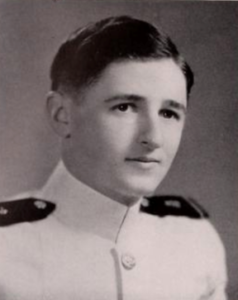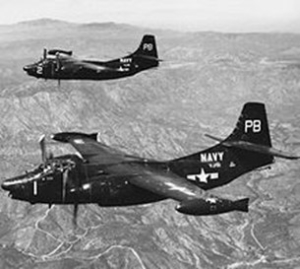Scroll of Honor – McFaddin Moise
Clemson to Annapolis
Written by: Kelly Durham
McFaddin Moise of Sumter began his collegiate career at Clemson College enrolling in the late summer of 1940. He was a member of the Sumter County Club and remained on campus for two years before transferring, in the midst of World War II, to the United States Naval Academy at Annapolis, Maryland. At Annapolis, Moise played soccer on the Academy’s plebe, junior varsity, and varsity squads and, despite “some worry” during his plebe year, handled the academic rigors of a midshipman. The Lucky Bag, the Academy’s yearbook, noted that Moise’s “encounters with the Executive Department,” which meted out disciplinary corrections to midshipmen, “were fewer than average due to two years of previous experience at Clemson College.” Moise, a member of the Academy’s Class of 1946, actually graduated in June 1945. Due to the war, the entirety of the midshipmen’s junior year was removed from the curriculum.
 Moise was immediately assigned to a minesweeper serving in Japanese waters. After the war’s conclusion, as the Navy reduced its strength, Moise was put in command of the ship for its return voyage to Charleston Navy Base. Following an assignment in underwater research at Hampton, Virginia, Moise requested and was granted a transfer to the Navy’s aviation arm. On December 21, 1948, Moise married Betty Garris of Andrews.
Moise was immediately assigned to a minesweeper serving in Japanese waters. After the war’s conclusion, as the Navy reduced its strength, Moise was put in command of the ship for its return voyage to Charleston Navy Base. Following an assignment in underwater research at Hampton, Virginia, Moise requested and was granted a transfer to the Navy’s aviation arm. On December 21, 1948, Moise married Betty Garris of Andrews.
Upon completion of flight training, Moise reported to Chincoteague Naval Air Station, Virginia as part of the Atlantic Fleet. He was next ordered to Pensacola, Florida for jet training. Then came an assignment to the Navy’s flight testing facility at Patuxent River Naval Air Station in Maryland.
On Wednesday, February 4, 1953, Lieutenant Moise and Aviation Machinist James Vaughn climbed into an AJ-2 Savage for a  routine armaments test. The Savage was a medium bomber designed to carry atomic bombs from the decks of Navy aircraft carriers. As such, it was at the time of its development the heaviest aircraft to operate from a carrier. It was powered by two wing-mounted piston engines plus a turbojet incorporated into the rear of the fuselage.
routine armaments test. The Savage was a medium bomber designed to carry atomic bombs from the decks of Navy aircraft carriers. As such, it was at the time of its development the heaviest aircraft to operate from a carrier. It was powered by two wing-mounted piston engines plus a turbojet incorporated into the rear of the fuselage.
Upon take off, Moise’s aircraft climbed 200 feet into the air and was then struck by a “mechanical failure.” The plane crashed into Chesapeake Bay killing both Moise and Vaughn. Moise was buried in the family plot in the Sumter Cemetery. He was survived by his wife, son McFaddin, Jr. then two-and-a-half, daughter Mary Frances, eight months, his parents, four brothers, and a sister.
 For more information about Lieutenant Moise McFaddin see:
For more information about Lieutenant Moise McFaddin see:
https://soh.alumni.clemson.edu/scroll/mcfaddin-moise/
For additional information about Clemson University’s Scroll of Honor visit:
